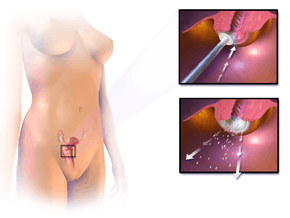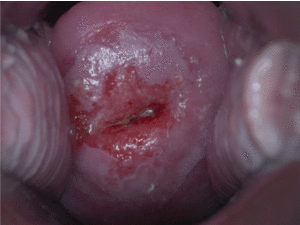Cervical intraepithelial neoplasia
| Cervical intraepithelial neoplasia | |
|---|---|
| cervical dysplasia, cervical interstitial neoplasia | |
|
Positive visual inspection with acetic acid of the cervix for CIN-1 | |
| Classification and external resources | |
| Specialty | Gynecology |
| ICD-10 | D06, N87 |
| ICD-9-CM | 233.1, 622.10 |
| MedlinePlus | 001491 |
| MeSH | D018290 |
Cervical intraepithelial neoplasia (CIN), also known as cervical dysplasia, is the potentially premalignant transformation and abnormal growth (dysplasia) of squamous cells on the surface of the cervix.[1] Cervical Intraepithelial Neoplasia most commonly occurs on the cervix at the squamo-columnar junction, but can also occur in vaginal walls and vulvar epthelium. The New Bethesda System reports all gynecologic abnormalities termed SIL Squamous intraepithelial lesions, arising from all areas of femal genital tract and anal canal of both men and women. Like other intraepithelial neoplasias, CIN or [SIL] is not cancer, and it is usually curable.[2] Most cases of CIN remain stable, or are eliminated by the host's immune system without intervention. However a small percentage of cases progress to become cervical cancer, usually cervical squamous cell carcinoma (SCC), if left untreated.[3] The major cause of CIN is chronic infection of the cervix with the sexually transmitted human papillomavirus (HPV), especially the high-risk HPV types 16 or 18. Over 100 types of HPV have been identified. About a dozen of these types appear to cause cervical dysplasia and may lead to the development of cervical cancer. Other types cause warts.
The earliest microscopic change corresponding to CIN is dysplasia of the epithelial or surface lining of the cervix, which is essentially undetectable by the woman. Cellular changes associated with HPV infection, such as koilocytes, are also commonly seen in CIN. CIN is usually discovered by a screening test, the Papanicolau or "Pap" smear. The purpose of this test is to detect potentially precancerous changes. Pap smear results may be reported using the Bethesda System. An abnormal Pap smear result may lead to a recommendation for colposcopy of the cervix, during which the cervix is examined under magnification. A biopsy is taken of any abnormal appearing areas. Cervical dysplasia can be diagnosed by biopsy. A test for Human Papilloma Virus called the Digene HPV test is highly accurate and serves as both a direct diagnosis and adjuvant to the all important pap test which is a screening device and not the final answer in detecting all types of female genital cancers. Endocervical.brush sampling at time of pap smear to detect adenocarcinoma and its precursors is necessary along with a patient/Dr. vigilance on abdominal symptoms associated with uterine and ovarian carcinoma.
Risk factors
Some groups of women have been found to be at a higher risk of developing CIN:[1]
- Women who become infected by a "high risk" type of HPV, such as 16, 18, 31, or 33
- Women who are immunodeficient
- Women who give birth before age 17
A number of risk factors have been shown to increase a woman's likelihood of developing CIN,[4] including poor diet, multiple sexual partners, lack of condom use, and cigarette smoking.
Classification
Depending on several factors and the location of the infection, CIN can start in any of the three stage, and can either progress, or regress.[1] The grade of squamous intraepithelial lesion can vary.
CIN is classified in grades:
| Histology Grade | Corresponding Cytology | Description | Image |
|---|---|---|---|
| – | – | Normal cervical epithelium | _normal_squamous_epithelium.jpg) |
| CIN 1 (Grade I) | LSIL[5] | The least risky type, represents only mild dysplasia, or abnormal cell growth.[3] It is confined to the basal 1/3 of the epithelium. This usually corresponds to infection with HPV, and may be cleared by immune response, though it can take several years to clear. | _koilocytosis.jpg) |
| CIN 2/3 | HSIL | Formerly subdivided into CIN2 and CIN3. | |
| CIN 2 (Grade II) | Moderate dysplasia confined to the basal 2/3 of the epithelium | _CIN2.jpg) | |
| CIN 3 (Grade III) | Severe dysplasia that spans more than 2/3 of the epithelium, and may involve the full thickness. This lesion may sometimes also be referred to as cervical carcinoma in situ. | _CIN3.jpg) |
Treatment

Treatment for CIN 1, which is mild dysplasia, is not recommended if it lasts fewer than 2 years.[6] Usually when a biopsy detects CIN 1 the woman has an HPV infection which may clear on its own within 12 months, and thus it is instead followed for later testing rather than treated.[6]
Treatment for higher grade CIN involves removal or destruction of the neoplastic cervical cells by cryocautery, electrocautery, laser cautery, loop electrical excision procedure (LEEP), or cervical conization. Therapeutic vaccines are currently undergoing clinical trials. The lifetime recurrence rate of CIN is about 20%, but it isn't clear what proportion of these cases are new infections rather than recurrences of the original infection.
Surgical treatment of CIN lesions is associated with an increased risk of infertility or subfertility, with an odds ratio of approximately 2 according to a case-control study.[7]
The treatment of CIN during pregnancy increases the risk of premature birth.[8]
Prognosis
It used to be thought that cases of CIN progressed through these stages toward cancer in a linear fashion.[3][9][10]
However most CIN spontaneously regress. Left untreated, about 70% of CIN-1 will regress within one year, and 90% will regress within two years.[11] About 50% of CIN 2 will regress within 2 years without treatment.
Progression to cervical carcinoma in situ (CIS) occurs in approximately 11% of CIN1 and 22% of CIN2. Progression to invasive cancer occurs in approximately 1% of CIN1, 5% in CIN2 and at least 12% in CIN3.[12]
Progression to cancer typically takes 15 (3 to 40) years. Also, evidence suggests that cancer can occur without first detectably progressing through these stages and that a high grade intraepithelial neoplasia can occur without first existing as a lower grade.[1][3][13]
It is thought that the higher risk HPV infections, have the ability to inactivate tumor suppressor genes such as the p53 gene and the RB gene, thus allowing the infected cells to grow unchecked and accumulate successive mutations, eventually leading to cancer.[1]
Treatment does not affect the chances of getting pregnant but does increase the risk of second trimester miscarriages.[14]
Epidemiology
Between 250,000 and 1 million American women are diagnosed with CIN annually. Women can develop CIN at any age, however women generally develop it between the ages of 25 to 35.[1]
See also
References
- 1 2 3 4 5 6 Kumar, Vinay; Abbas, Abul K.; Fausto, Nelson; Mitchell, Richard N. (2007). Robbins Basic Pathology (8th ed.). Saunders Elsevier. pp. 718–721. ISBN 978-1-4160-2973-1.
- ↑ Cervical Dysplasia: Overview, Risk Factors
- 1 2 3 4 Agorastos T, Miliaras D, Lambropoulos A, Chrisafi S, Kotsis A, Manthos A, Bontis J (2005). "Detection and typing of human papillomavirus DNA in uterine cervices with coexistent grade I and grade III intraepithelial neoplasia: biologic progression or independent lesions?". Eur J Obstet Gynecol Reprod Biol. 121 (1): 99–103. doi:10.1016/j.ejogrb.2004.11.024. PMID 15949888.
- ↑ Murthy NS, Mathew A (February 2000). "Risk factors for pre-cancerous lesions of the cervix". European Journal of Cancer Prevention. 9 (1): 5–14. doi:10.1097/00008469-200002000-00002. PMID 10777005. 10777005.
- ↑ Park J, Sun D, Genest D, Trivijitsilp P, Suh I, Crum C (1998). "Coexistence of low and high grade squamous intraepithelial lesions of the cervix: morphologic progression or multiple papillomaviruses?". Gynecol Oncol. 70 (3): 386–91. doi:10.1006/gyno.1998.5100. PMID 9790792.
- 1 2 American Congress of Obstetricians and Gynecologists, "Five Things Physicians and Patients Should Question", Choosing Wisely: an initiative of the ABIM Foundation, American Congress of Obstetricians and Gynecologists, retrieved August 1, 2013, which cites
- Wright, T. C.; Massad, L. S.; Dunton, C. J.; Spitzer, M.; Wilkinson, E. J.; Solomon, D.; 2006 American Society for Colposcopy Cervical Pathology-sponsored Consensus Conference (2007). "2006 consensus guidelines for the management of women with cervical intraepithelial neoplasia or adenocarcinoma in situ". American Journal of Obstetrics and Gynecology. 197 (4): 340–345. doi:10.1016/j.ajog.2007.07.050. PMID 17904956.
- &Na; (2008). "ACOG Practice Bulletin No. 99: Management of Abnormal Cervical Cytology and Histology". Obstetrics & Gynecology. 112 (6): 1419–1444. doi:10.1097/AOG.0b013e318192497c. PMID 19037054.
- ↑ Spracklen, C. N.; Harland, K. K.; Stegmann, B. J.; Saftlas, A. F. (2013). "Cervical surgery for cervical intraepithelial neoplasia and prolonged time to conception of a live birth: A case-control study". BJOG: an International Journal of Obstetrics & Gynaecology. 120 (8): 960–965. doi:10.1111/1471-0528.12209. PMC 3691952
 . PMID 23489374.
. PMID 23489374. - ↑ Kyrgiou, M; Athanasiou, A; Paraskevaidi, M; Mitra, A; Kalliala, I; Martin-Hirsch, P; Arbyn, M; Bennett, P; Paraskevaidis, E (28 July 2016). "Adverse obstetric outcomes after local treatment for cervical preinvasive and early invasive disease according to cone depth: systematic review and meta-analysis.". BMJ (Clinical research ed.). 354: i3633. PMID 27469988.
- ↑ Hillemanns P, Wang X, Staehle S, Michels W, Dannecker C (2006). "Evaluation of different treatment modalities for vulvar intraepithelial neoplasia (VIN): CO(2) laser vaporization, photodynamic therapy, excision and vulvectomy". Gynecol Oncol. 100 (2): 271–5. doi:10.1016/j.ygyno.2005.08.012. PMID 16169064.
- ↑ Rapp L, Chen J (1998). "The papillomavirus E6 proteins". Biochim Biophys Acta. 1378 (1): F1–19. doi:10.1016/s0304-419x(98)00009-2. PMID 9739758.
- ↑ Bosch FX, Burchell AN, Schiffman M, Giuliano AR, de Sanjose S, Bruni L, Tortolero-Luna G, Kjaer SK, Muñoz N (August 2008). "Epidemiology and natural history of human papillomavirus infections and type-specific implications in cervical neoplasia". Vaccine. 26 (Supplement 10): K1–16. doi:10.1016/j.vaccine.2008.05.064. PMID 18847553. 18847553.
- ↑ Section 4 Gynecologic Oncology > Chapter 29. Preinvasive Lesions of the Lower Genital Tract > Cervical Intraepithelial Neoplasia in:Bradshaw, Karen D.; Schorge, John O.; Schaffer, Joseph; Lisa M. Halvorson; Hoffman, Barbara G. (2008). Williams' Gynecology. McGraw-Hill Professional. ISBN 0-07-147257-6.
- ↑ Monnier-Benoit S, Dalstein V, Riethmuller D, Lalaoui N, Mougin C, Prétet J (2006). "Dynamics of HPV16 DNA load reflect the natural history of cervical HPV-associated lesions". J Clin Virol. 35 (3): 270–7. doi:10.1016/j.jcv.2005.09.001. PMID 16214397.
- ↑ Kyrgiou, M; Mitra, A; Arbyn, M; Stasinou, SM; Martin-Hirsch, P; Bennett, P; Paraskevaidis, E (28 October 2014). "Fertility and early pregnancy outcomes after treatment for cervical intraepithelial neoplasia: systematic review and meta-analysis.". BMJ (Clinical research ed.). 349: g6192. doi:10.1136/bmj.g6192. PMID 25352501.
